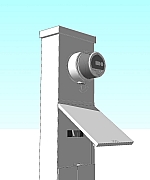Successful companies use 3D construction models to clearly communicate their ideas and win new projects. These models are a powerful way to deliver and understand construction information because they clearly convey the details of a structure and the actions necessary for its assembly. The models also visually communicate questions and alternatives during construction, setting the stage for an efficient and coordinated production process.
Deteriorating Construction Information.
It’s no secret that the quality of construction drawings has been steadily declining. Facing lower fees, higher risks, and the demand for more information, many designers use stock sheet templates, standard details, and server side resources that allow computer operators to piece together hundreds of sheets of documents with little time to check the results.
As a consequence, poorly drawn construction documents set the stage for adversarial relationships that begin with bid clarifications, memos, and addenda and evolve into hundreds of requests for information (RFI) during construction. These RFIs are regularly followed by field bulletins to correct or stop ongoing work and change orders to adjust the scope and cost of the original contract. Add to all this paperwork revised specifications, daily reports, letters, meeting minutes, and emails and the shear quantity of information quickly becomes overwhelming.


Light & Fast Graphic Communications
The value of our books is that they demonstrate the use of SketchUp as a graphical tool that can streamline the challenges of construction communications. Our objective is to show how construction models can be used as a common collaborative point of view. This reduces redundant communications and the time it takes to describe and explain what can more easily by conveyed in an illustration.
Important is that anyone can build a simple 3D model. This means every person on the project team is able to contribute to the project using models to establish a common point of view.


Guerilla graphics
Model construction is quick, simple, and intuitive. Layer and object level controls are used to stage the model for screenshots. These screenshots are edited and imported into a desktop publishing program, or inserted into email, spreadsheet, word processor, or presentation programs. The resulting images represent strategies, illustrate questions and answers, demonstrate solutions, or visually communicate a series of distinct activities.
Completed models are also a resource for new models. Our readers are encouraged to “pick and pull” pieces or assemblies from our models and use them on their own projects. In other words, the equipment, frames, and mechanical systems included in the models with our books can be used to build almost any other project.
For example, the materials and methods found in “How a House is Built” or “3D Construction Modeling” can be reassembled to build a construction model of almost any imaginable house.
In the same way, the equipment, formwork, and mechanical systems found in “Building SIMPLE” and “Being SUSTAINABLE” can be quickly reassembled to represent almost any type of commercial building.
Competitive Construction Communications
If a picture is worth a thousand words, and a model can generate a thousand pictures, a single construction model can easily illustrate even the most complicated assembly. This makes a three-dimensional model a critical resource in competitive construction communications.








